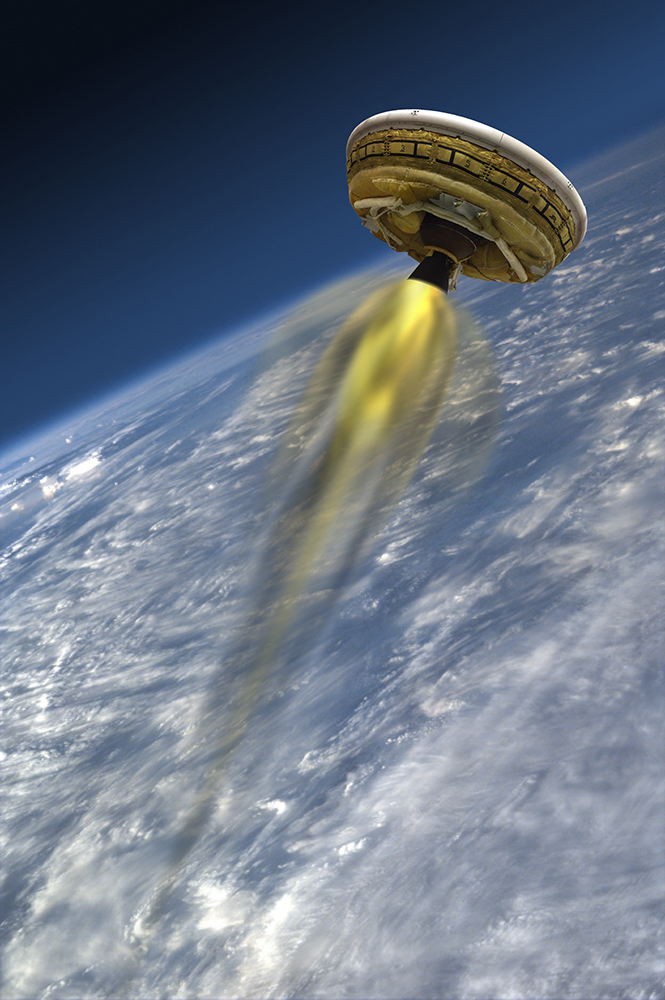
NASA’s latest parachute cordage is Yale-engineered
NASA launched a spacecraft 180,000 feet over the Pacific Ocean to simulate the supersonic entry and descent speeds at which the craft would travel through the Martian atmosphere.
The testing will help produce a major breakthrough for future robotic and human missions to Mars. They tested several pieces of technology with the launch, but one of the most closely-watched components will be an innovative parachute system that uses Yale Cordage Rope.
Per the NASA website, the Low-density Supersonic Decelerator (LDSD) project is “designed to investigate and test breakthrough technologies for landing future robotic and human Mars missions, and for safely returning large payloads to Earth.”
At a press conference on Monday from the launch site at the U.S. Navy’s Pacific Missile Range Facility (PMRF) on Kauai, Hawaii, key members of the LDSD team gave an overview of what the test would entail, and also what it means in a broader context.
“Right now, we are kind of at the technological limits of what we can land on Mars in terms of size and weight,” said Steve Jurczyk, Assoc. Admin of NASA’s Space Technology Mission Directorate, which innovates, develops, tests and flies hardware for NASA’s future missions, at Monday’s briefing. He went on to explain that the Curiosity Rover, which landed in 2012 and is still in service, weighs about one metric ton (2,200 lbs.) at roughly the size of a Mini Cooper, represents about all we can do with the current technology, which was developed based on data from the 1960s and ‘70s.
Jurczyk went on to explain that the new technology is required to land 5 metric tons for human missions, maybe 30 or more metric tons to the surface, with a key component being a supersonic parachute 100 feet in diameter that can improve landed mass up to 200 percent. This would represent a crucial technological advancement as NASA moves toward its 2030s vision of human exploration on Mars.
NASA could be using this technology in robotic Mars missions as early as the 2020s.
NASA’s LDSD test vehicle carries several onboard cameras, meaning that you can watch our Teijin’s Technora® bullet take flight via Ustream or NASA TV .. NASA will also issue updates on Twitter at @NASA and @NASA_Technology.
The Cordage
Yale Cordage makes the bridle that attaches the actual lander to the parachute.
To create the custom rope, Yale braided 12 Teijin’s Technora® single-braid ropes together to create a larger rope, then split out all 12 individual ropes on the end that attaches to the parachute, and just three ends on the other side where the rope attaches to the lander.
The whole apparatus along with the parachute gets compacted and stuffed into a missile-looking tube that is only about three feet tall by one foot in diameter – if that. Then it shoots out the back of the lander itself, next to the rocket.
The iterative testing leading up to the launch has involved bringing the parachute up with a helicopter, letting it go, and then lighting a rocket sled that takes off across land, simulating the pull of the parachute to the ground. You can view the test and the full apparatus in this video from the NASA Propulsion Laboratory (the bright yellow rope is ours).
Teijin’s Technora® was the perfect rope for the job because of its high strength to light weight ratio combined with its impressive heat resistance. In a normal parachute deployment, the chute comes out and starts to slow the load, and then when it fully deploys there’s a jerk from deceleration. In this case, though, the chute goes from max speed to fully deployed in a second without slowing down at all – so the rope needed to stand up to the heat created by that resultant friction and also have maximum energy absorption capabilities. How to Watch the Launch NASA’s LDSD test vehicle carries several onboard cameras, meaning that you can watch our Teijin’s Technora® bullet take flight via Ustream or NASA TV .. NASA will also issue updates on Twitter at @NASA and @NASA_Technology.
How it Works
According to the LDSD site,
At launch time, a giant balloon will carry the test vehicle to an altitude of 120,000 feet (37,000 meters). After released from the balloon, a booster rocket will lift the disk-shaped vehicle to 180,000 feet (55,000 meters), during which it will accelerate to supersonic speeds.
Traveling at about three times the speed of sound, the vehicle’s inner-tube-shaped decelerator, called a supersonic inflatable aerodynamic decelerator, will inflate and slow the vehicle. Then, at Mach 2.35, its parachute will inflate and gently carry the vehicle to the ocean’s surface.
This is the second full LDSD test launch over Hawaii. The first happened last June, during which the SIAD operated successfully and the bridle cordage held up, but the parachute did not inflate.
How to Watch the Launch
NASA’s LDSD test vehicle carries several onboard cameras, meaning that you can watch our Teijin’s Technora® bullet take flight via Ustream or NASA TV .. NASA will also issue updates on Twitter at @NASA and @NASA_Technology.


